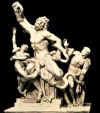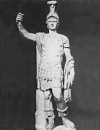During the Classical Period the people
called their states Hellas. The origin of the word Greece come from Latin, which is the language of
the Roman.
The culture of the ancient Greek is the first civilization of high level within Western-Europe and in general is known as the
origin or basis of the Westeuropean civilization. The development of the ancient Greek continued during 650 years from about 800
to 140 b.C. Within this timeframe there was a period of development, prospherity and wealth and a period of deterioration.
These phases are called the archaic, classic and hellenistic period.
 The Archaic period is the period from 800 to 500 b.C.
The word archaic is from Greek origin and freely translated means 'from the beginning'. During this phase the first big temples
were build and also painting and the contruction of monumental sculptures began to develop.
The Archaic period is the period from 800 to 500 b.C.
The word archaic is from Greek origin and freely translated means 'from the beginning'. During this phase the first big temples
were build and also painting and the contruction of monumental sculptures began to develop.
The Classic period is from about 500 to 350 b.C. In this period nearly all possible cultural expressions florished:
philosophy, politics, literature, music, painting, sculpture and architecture. The achievements from this era have been of enormous
influence throughout history. Therefore this period can be called classic as well as Golden Age of the Ancient Greek.
 The
Hellenistic period is from 350 to 140 b.C. This period begins with the conquers of Alexander
the Great. His empire reached from Greece to
The
Hellenistic period is from 350 to 140 b.C. This period begins with the conquers of Alexander
the Great. His empire reached from Greece to  far within the Middle-East. During time the influence
and dominion of the Greek became less and less until the Roman took over their leading position in the second century b.C. In about 140 b.C. Greece became a province of the Roman Empire.
far within the Middle-East. During time the influence
and dominion of the Greek became less and less until the Roman took over their leading position in the second century b.C. In about 140 b.C. Greece became a province of the Roman Empire.
Balance, harmony, has been a very important concept during the Classic Period. Optimal harmony was believed to be a sign of divinity.
Therefore training the body and the spirit to obtain harmony was a very important part in the education of the young Greek.
The people strove for spiritual as well as physical perfection.
In the Ancient Greek period human formed the center of the universe. Human, as being independent human being, as
well as life itself played a central role in the Greek society. Their religion that was based on
myths also influenced their society.
Within the art from the Greek Period all above mentioned elements can be found. The design of the artworks was determined by their
aspiration for harmony and beauty and by realizing the most realistic reproduction. The inspiration and subjects for their art came
from historic events, mythology and their daily rituals.

 The best known construction from the
Greek Period is the temple. The Greek temple consists of several spaces with the cella being the most important. In the cella
they placed the statue of the God of the temple, like Zeus, Apollo or Athene. However the architecture and construction of the
Greek temple stayed nearly the same during several ages, we can still distinguish 3 different styles:
Doric,
Ionic and
Corinthic. The main differences between these 3 styles can be found
in the number of steps to enter the building, the construction of the pillars and the intensity of decoration.
The best known construction from the
Greek Period is the temple. The Greek temple consists of several spaces with the cella being the most important. In the cella
they placed the statue of the God of the temple, like Zeus, Apollo or Athene. However the architecture and construction of the
Greek temple stayed nearly the same during several ages, we can still distinguish 3 different styles:
Doric,
Ionic and
Corinthic. The main differences between these 3 styles can be found
in the number of steps to enter the building, the construction of the pillars and the intensity of decoration.
 The first temples in Greece were build
of wood. Around 600 b.C. the first temples of stone were build. The best examples of Greek temple-construction date from the
classic period with the Parthenon (448-432 b.C.) as one of the most famous temples. The Parthenon is on of the hightlights of
Greek architecture due to the harmony and elegance of the enormous construction.
The first temples in Greece were build
of wood. Around 600 b.C. the first temples of stone were build. The best examples of Greek temple-construction date from the
classic period with the Parthenon (448-432 b.C.) as one of the most famous temples. The Parthenon is on of the hightlights of
Greek architecture due to the harmony and elegance of the enormous construction.
To be continued .......


